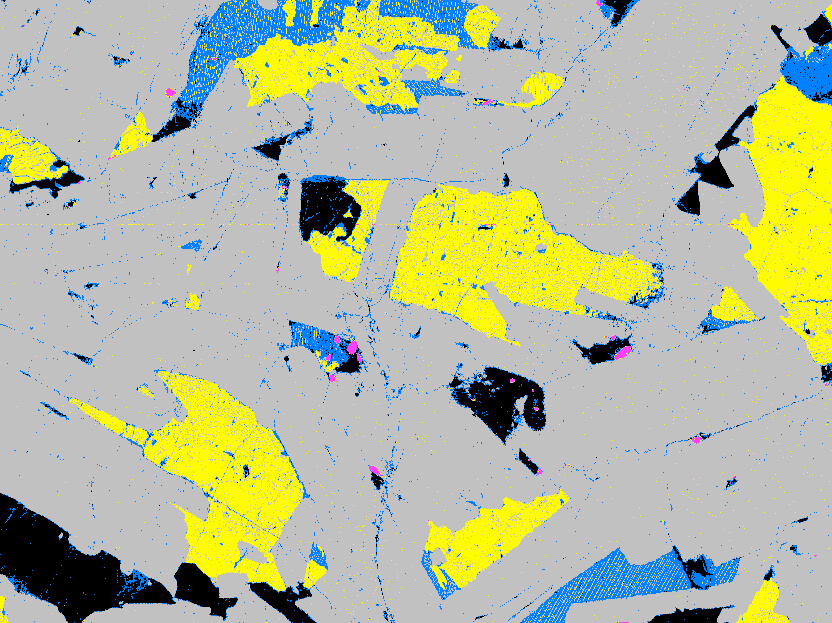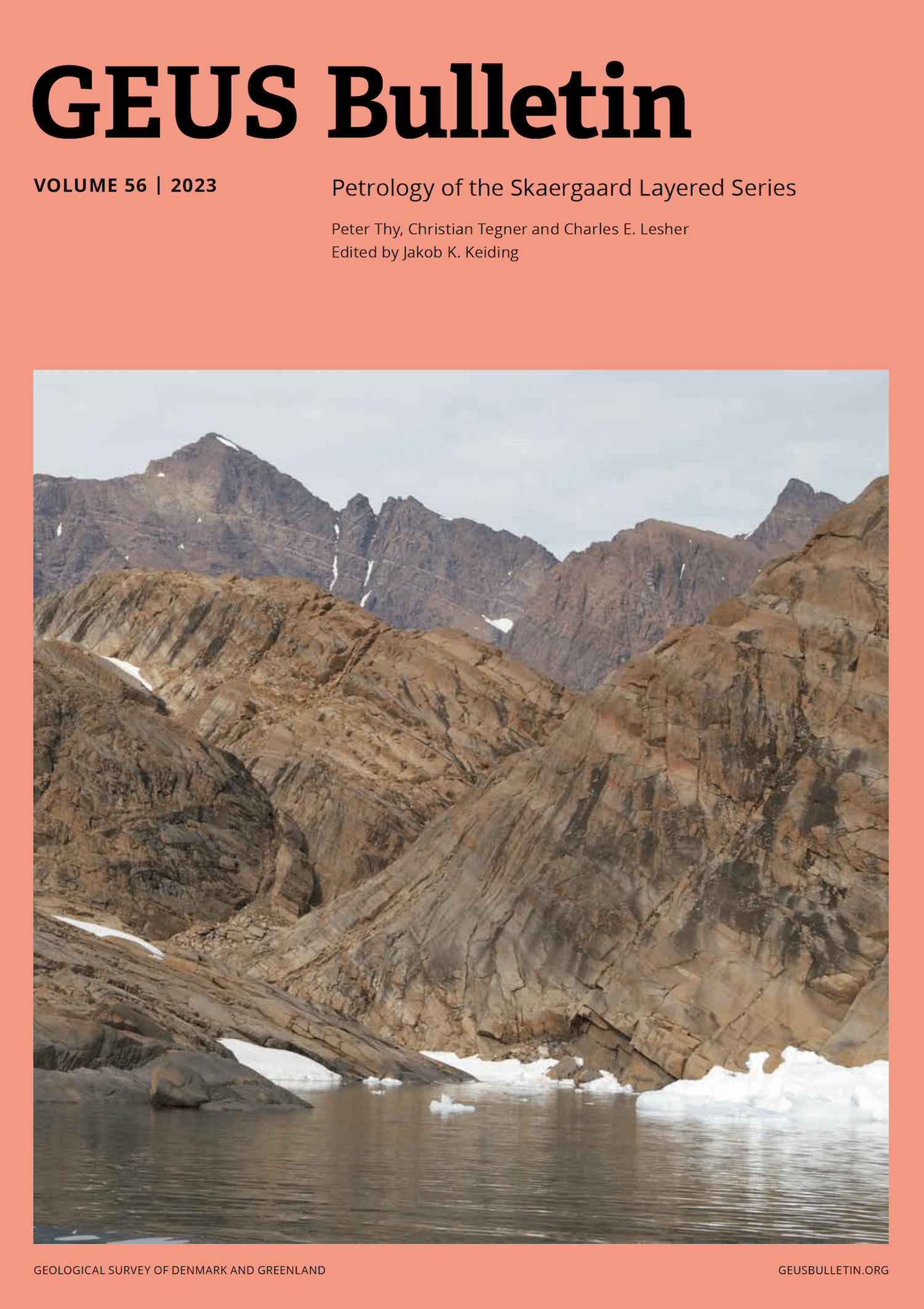
How to Cite
Share
Abstract
The Palaeogene Skaergaard intrusion, East Greenland, has since its first description by Wager & Deer (1939) been a foremost natural laboratory for the study of low-pressure fractionation of basaltic melt. Ocean floors are composed of basalt and the processes that control compositions of basaltic melts are fundamental to the dynamics of the Earth. This special issue of GEUS Bulletin by Peter Thy, Christian Tegner and Charles E. Lesher is the most recent in a more than eighty year succession of trendsetting works on the evolution of the Skaergaard intrusion and evolution of basaltic melt.
The early sample collections, housed in the universities of Oxford and Cambridge, were used for the development of fractionation models, mapping of the distribution as well as the partition of major and trace elements between melts and liquidus phases in basaltic melts. These and many other studies resulted in the monumental “Layered Igneous Rocks”, edited by L.R. Wager and G.M. Brown (Wager & Brown 1968).
By the 1970s, the original collection in the Oxford University Museum of Natural History and the Sedgwick Museum of Earth Sciences, University of Cambridge had seen extensive use. The science developed and new and more detailed sampling was now required. Fieldwork and sampling in the later part of the 20th century led to a flurry of new studies by more research groups, including Neil Irvine of Carnegie’s Geophysical Laboratory and the University of Oregon group lead by Alex McBirney. Despite all the efforts, no consensus was reached on the many fundamental chemical and physical processes in basaltic magma chambers.
The available collections did not provide sufficiently systematic and detailed information for the modelling of the evolution of the basaltic melt and the genesis of the precious metal deposit that had been discovered in the intrusion.
Exploration drill cores offered the possibility for tight stratigraphic sampling through >1000 m of gabbro. In combination with surface sampling, a new standard profile with superior systematics could be established. In the summer of 2000, the Danish Lithosphere Centre (DLC) organised fieldwork and the transport of the drill cores to the Museum of Natural History in Copenhagen. This special issue is part of the legacy of the DLC and a fulfilment of the then envisaged potential of the Skaergaard intrusion for fundamental studies of processes in basaltic magma chambers.
Thy et al. (2023, this volume) analyse and compile in unprecedented detail the variation in major and trace element compositions of bulk-rock samples and electron microprobe compositions of rock-forming minerals in the Layered Series on the floor of the intrusion. In addition, they include a wealth of information on all samples from the Skaergaard intrusion that are housed in museum, university and survey collections in Denmark, the UK and US, topographic and geological maps, aerial photographs in archives and images of thin sections used in the study.
With all its data and appendices, the monograph is the most comprehensive collection of petrological information for the Skaergaard intrusion and the Layered Series on the floor of the intrusion, ever to have been made available for research. The detailed modelling presented re-evaluates petrogenetic constraints and tests petrogenetic models in the literature.
The modelling is based on liquidus proportions established in experimental studies of appropriate melt compositions. Thy and co-authors conclude that evolution observed in the gabbros of the Layered Series is predominantly controlled by crystal fractionation of bulk liquid. Late in the evolution and above the boundary between Upper Zone a and b, the gabbros crystallised from ponded Fe-rich, immiscible melt. Redistribution of granophyric melts and decoupling of included and excluded trace elements, not only in bulk liquid but also in mush melts, complicates the modelling of trace element distributions in the late and evolved stages of crystallisation in the crystal mushes of the intrusion.
This special issue is a treasure trove for all who study the intrusion and are searching for a data set to be matched with experimental and numeric modelling of low-pressure fractionation of basaltic melt. With this contribution, the Skaergaard intrusion continues to be a foremost natural laboratory for modelling of melts formed in solidifying basaltic magma chambers.
Troels F.D. Nielsen
Emeritus, GEUS, Denmark
How to Cite
Share
Copyright (c) 2023 Troels F.D Nielsen

This work is licensed under a Creative Commons Attribution 4.0 International License.
Funding
None declaredDownloads
Authors: Peter Thy, Christian Tegner and Charles E. Lesher
Editor: Jakob K. Keiding
The Skaergaard intrusion is a layered, ferrobasaltic intrusion emplaced during the Early Eocene into the rifting volcanic margin of East Greenland. In this special issue the authors, Peter Thy, Christian Tegner and Charles E. Lesher present a comprehensive review [...]
References
- Thy, P., Tegner, C., & Lesher, C.E. 2023: Petrology of the Skaergaard Layered Series. GEUS Bulletin 56, 8327 (this volume). https://doi.org/10.34194/geusb.v56.8327
- Wager, L.R. & Deer, W.A. 1939: Geological investigations in East Greenland: Part III. The petrology of the Skaergaard intrusion, Kangerdlugssuaq, East Greenland. Meddelelser om Grønland 105, 352 pp.
- Wager, L.R. & Brown, G.M. 1968: Layered igneous rocks, 588 pp. Edinburgh & London: Oliver & Boyd.









